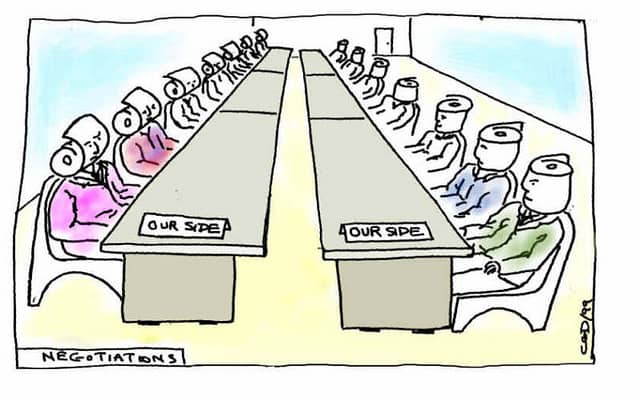What is Negotiation?
Negotiation is the process of making joint decisions when the parties involved in negotiation have different and opposing preferences. Negotiation has special significance in situations of conflict, whether it is conflict between union and management in organizations or between countries such as China and Japan where negotiations may be required to resolve the conflict over disputed island. Conflicts and disagreements are likely to arise in work settings over such diverse matters as wages, performance evaluation, working conditions, job assignments, work schedules and so on.
In any type of negotiations, two important goals must be considered. One goal involves substance and other involves relationships. Reaching agreement on wage increases would be achievement of substance goal. The relationship goal deals with the outcomes that relate to how well the negotiating parties are able to work with each other, once the negotiation process has been concluded.
An effective negotiation occurs when substance issues are resolved without negatively affecting the working relationships. In most organizations in America, the union and management remain in good and cordial relationship after the fight is over.
Negotiation Strategies
Many different strategies of negotiation have been put forward by theorists and practitioners, but they generally follow one of the two approaches. One is known as the ‘distributive negotiation’, and the other is known as the ‘integrative negotiation’.
The distributive negotiation is a zero sum game in which parties are in a state of competition, whereby each party seeks dominance over the other and tries to maximize its own self-interests. Since the self-interest is to get the most out of the available resources and since the pool of the available resources is fixed, whatever one party wins, the other party must lose.
Integrative negotiation, on the other hand, is a collaborative model in which the parties seek to expand the range of possible outcomes and thereby maximize their individual benefits by shoring in the collective efforts and results. For example, a union may get better wages and in response may produce more in terms of quantity and quality. In such a situation, both the union as well as the management wins.
Characteristics of Distributive Negotiations
A case of distributive negotiation can either be a hard one or a soft one. The hard distributive negotiation takes place when each party holds out for what it wants without any compromise. Many times such attitude leads to on impasse. This happened in the case of Eastern Airlines, where the union’s demands were considered very high and the management refused to give in. The result was a strike by the workers and the end result was that the airline went into bankruptcy and ceased to exist.
In a soft distributive negotiation, both parties follow the give and take policy, make concessions, compromise on some issues and reach an agreement that is realistic and acceptable. In general, one party asks for much higher benefits than it is willing to accept and the other party offers much less than it is willing to give. Then by negotiation and compromise, they meet some where in the middle and both parties are happy. This meeting point is some where in the bargaining zone. This bargaining zone is defined by the following example:
‘A graduate with MBA degree is negotiating a job offer with a company manager. He believes that he should get $70,000 per year in salary but would be willing to settle for $60,000 per year. That is the lowest salary he will accept for the job. The manager would like to offer $55,000 per year but would be willing to go up to $65,000 per year. Thus the minimum value of $60,000 for the graduate and maximum offer of the manager of$65,000 create a bargaining zone between $60,000 and $65,000. Negotiation takes place within this zone.’ Similarly, purchasing a car or a house represents distribute negotiation with a bargaining zone to maneuver the price.
Distributive negotiation is a necessary way of resolving differences between parties with mutually exclusive goals. Parties to the negotiation will withhold as much information as possible to gain an advantage and at the same time, they will try to get as much information from the opposing party as possible. Negotiators will generally have a very good idea as to what they are trying to accomplish and this is perhaps the most critical point of skillful negotiation. Negotiation should focus on realistic issues and not on egos about winning and not losing.
Characteristics of Integrative Negotiations
Integrative negotiation is a process in which the negotiating parties jointly work towards goals that are not mutually exclusive so that one party does not necessarily gain at the expense of the other. The approach of the parties is to work together to find out ways to utilize the resources in a best possible manner for the benefit of both parties. They engage in problem solving jointly to arrive at a mutual agreement that maximizes benefit to each party.
Integrative negotiation has two aspects to it. One is the substantive part that includes the tangible issues to be discussed and negotiated. The other aspect is the intrinsic value in the agreement, that may be long-term cordial relationship between the parties or other benefits to both parties not directly related to the substance of the issues involved. Thus, it has an important dimension of building relationships.
The foundations for gaining truly integrative agreements rest on the following elements:
Supportive Attitudes: A supportive attitude requires that each party must be willing sincerely to trust the other party. This trust is based upon moral and ethical dimensions. Second, each party must be willing to share all relevant information with the other party, openly and honestly.
Behavioral Foundations: It is very important for the parties not to be emotional or personal. They must focus on issues and interests and not on positions and positions should be modified when necessary. The parties should avoid making premature judgements and should be willing to objectively look at the views offered by each party.
Information Foundation: These foundations involve each party becoming familiar with the ‘best alternative to a negotiated agreement’ or BATNA. This means that each party must know and be prepared for any alternative in case a settlement is not reached. It is important for each party to know what any other methods the opposing party will pursue in case the negotiations fail.
Not knowing the other party’s values and approach could put one party in a weaker position. If any of the two parties has a better alternative to negotiated settlement, such party would be in a stronger position. Accordingly, it is necessary to have as much information about the other party’s plans as possible.





